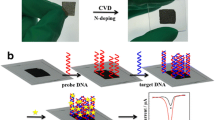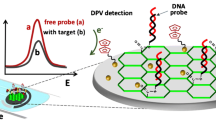Abstract
The authors describe a DNA based voltammetric assay for the cancer biomarker microRNA-25. A glassy carbon electrode (GCE) was modified with amino-functionalized graphene quantum dots and used as an amplifier of electrochemical signals. p-Biphenol is introduced as a new electroactive probe with a fairly low working potential of 0.3 V (vs. Ag/AgCl). The stages of fabricating the electrode were characterized by cyclic voltammetry and electrochemical impedance spectroscopy. ss-Probe DNA was immobilized on the modified GCE and then exposed to a sample containing microRNA-25. The results indicated that the electrode can distinguish complementary microRNA-25 from a single-base mismatch. The increase in the electrochemical response of PBP and the positive shift in the potential peak indicate that PBP is intercalated between two strands. Under optimized experimental conditions, the current of the electrode increases linearly with the logarithm of the microRNA-25 concentration in the range from 0.3 nM to 1.0 μM, and the detection limit is 95.0 pM. The assay was successfully employed to the determination of microRNA-25 in spiked human plasma.

A novel electrochemical nanogenosensor is introduced for simple and sensitive determination of microRNA-25, as a biomarker, based on amino-functionalized graphene quantum dots (as a surface modifier) and p-biphenol (as an electroactive label).






Similar content being viewed by others
References
Li L, Xiao B, Tong H, Xie F, Zhang Z, Xiao GG (2012) Regulation of breast cancer tumorigenesis and metastasis by miRNAs. Expert Rev Proteomics 9:615–625
Chen Z-Y, Chen X, Wang Z-X (2016) The role of microRNA-196a in tumorigenesis, tumor progression, and prognosis. Tumor Biol 37:15457–15466
Tüfekci KU, Öner MG, Meuwissen RLJ, Genç Ş (2014) The role of microRNAs in human diseases. miRNomics: MicroRNA biology and computational analysis. In: Methods in Molecular Biology (Methods and Protocols), vol 1107. Humana Press, Totowa
Feng K, Liu J, Deng L, Yu H, Yang M (2018) Amperometric detection of microRNA based on DNA-controlled current of a molybdophosphate redox probe and amplification via hybridization chain reaction. Microchim Acta 185:28
Liu L, Jiang S, Wang L, Zhang Z, Xie G (2015) Direct detection of microRNA-126 at a femtomolar level using a glassy carbon electrode modified with chitosan, graphene sheets, and a poly (amidoamine) dendrimer composite with gold and silver nanoclusters. Microchim Acta 182:77–846
Zhou Y, Yin H, Li J, Li B, Li X, Ai S, Zhang X (2016) Electrochemical biosensor for microRNA detection based on poly (U) polymerase mediated isothermal signal amplification. Biosens Bioelectron 79:79–85
Wu T, Chen W, Kong D, Li X, Lu H, Liu S, Wang J, du L, Kong Q, Huang X, Lu Z (2015) miR-25 targets the modulator of apoptosis 1 gene in lung cancer. Carcinogenesis 36:925–935
Zhang H, Zuo Z, Lu X, Wang L, Wang H, Zhu Z (2012) MiR-25 regulates apoptosis by targeting bim in human ovarian cancer. Oncol Rep 27:594–598
Esposito F, Tornincasa M, Pallante P, Federico A, Borbone E, Pierantoni GM, Fusco A (2012) Down-regulation of the mir-25 and mir-30d contributes to the development of anaplastic thyroid carcinoma targeting the polycomb protein EZH2. J Clin Endocrinol Metab 97(5):E710–E718
Azimzadeh M, Rahaie M, Nasirizadeh N, Naderi-Manesh H (2015) Application of oracet blue in a novel and sensitive electrochemical biosensor for the detection of microRNA. Anal Methods 7:9495–9503
Rafiee-Pour H-A, Behpour M, Keshavarz M (2016) A novel label-free electrochemical miRNA biosensor using methylene blue as redox indicator: application to breast cancer biomarker miRNA-21. Biosens Bioelectron 77:202–207
Xia N, Wang X, Deng D, Wang G, Zhai H, Li S-J (2013) Label-free electrochemical sensor for MicroRNAs detection with ferroceneboronic acids as redox probes. Int J Electrochem Sci 8:9714–9722
Murakami Y, Ishii H, Hoshina S, Takada N, Ueki A, Tanaka S, Kadoma Y, Ito S, Machino M, Fujisawa S (2009) Antioxidant and cyclooxygenase-2-inhibiting activity of 4,4′-biphenol, 2,2′-biphenol and phenol. Anticancer Res 29:2403–2410
Deep A, Jain S, Sharma PC, Verma P, Kumar M, Dora CP (2010) Design and biological evaluation of biphenyl-4-carboxylic acid hydrazide-hydrazone for antimicrobial activity. Acta Pol Pharm 67:255–259
Belsare PU, Zade AB (2013) Synthesis, characterization and thermal study of 2, 2′-biphenol-tetraethylenepentamine-formaldehyde terpolymer resin. Der Pharma Chemica 5(4):325–334
Fraser DM (1994) Biphenol as an electron transfer mediator for glucose oxidase. Anal Lett 27:2039–2053
Shayani-Jam H, Nematollahi D (2011) Electrochemically mediated oxidation of glutathione and N-acetylcysteine with 4, 4′-biphenol. Electrochim Acta 56:9311–9316
Laurenti M, Paez-Perez M, Algarra M, Alonso-Cristobal P, Lopez-Cabarcos E, Mendez-Gonzalez D, Rubio-Retama J (2016) Enhancement of the upconversion emission by visible-to-near-infrared fluorescent graphene quantum dots for miRNA detection. ACS Appl Mater Interfaces 8:12644–12651
Huang S, Qiu H, Zhu F, Lu S, Xiao Q (2015) Graphene quantum dots as on-off-on fluorescent probes for chromium (VI) and ascorbic acid. Microchim Acta 182:1723–1731
Zhang T, Zhao H, Fan G, Li Y, Li L, Quan X (2016) Electrolytic exfoliation synthesis of boron doped graphene quantum dots: a new luminescent material for electrochemiluminescence detection of oncogene microRNA-20a. Electrochim Acta 190:1150–1158
Dong Y, Shao J, Chen C, Li H, Wang R, Chi Y, Lin X, Chen G (2012) Blue luminescent graphene quantum dots and graphene oxide prepared by tuning the carbonization degree of citric acid. Carbon 50:4738–4743
Sun H, Gao N, Wu L, Ren J, Wei W, Qu X (2013) Highly Photoluminescent amino-functionalized graphene quantum dots used for sensing copper ions. Chemistry Eur J 19:13362–13368
Panagopoulou MA, Stergiou DV, Roussis IG, Prodromidis MI (2010) Impedimetric biosensor for the assessment of the clotting activity of rennet. Anal Chem 82:8629–8636
Suni II (2008) Impedance methods for electrochemical sensors using nanomaterials. TrAC Trends Anal Chem 27:604–611
Razmi H, Mohammad-Rezaei R (2013) Graphene quantum dots as a new substrate for immobilization and direct electrochemistry of glucose oxidase: application to sensitive glucose determination. Biosens Bioelectron 41:498–504
Carter MT, Rodriguez M, Bard AJ (1989) Voltammetric studies of the interaction of metal chelates with DNA. 2. Tris-chelated complexes of cobalt (III) and iron (II) with 1, 10-phenanthroline and 2, 2′-bipyridine. J Am Chem Soc 111:8901–8911
Miller JN, Miller JC (2000) Statistics and Chemometrics for analytical chemistry, 4th Pearson education limited, Essex
Li F, Peng J, Wang J, Tang H, Tan L, Xie Q, Yao S (2014) Carbon nanotube-based label-free electrochemical biosensor for sensitive detection of miRNA-24. Biosens Bioelectron 54:158–164
Liu S, Su W, Li Z, Ding X (2015) Electrochemical detection of lung cancer specific microRNAs using 3D DNA origami nanostructures. Biosens Bioelectron 71:57–61
Chen Y, Xiang Y, Yuan R, Chai Y (2015) Intercalation of quantum dots as the new signal acquisition and amplification platform for sensitive electrochemiluminescent detection of microRNA. Anal Chim Acta 891:130–135
Asadzadeh-Firouzabadi A, Zare HR (2017) Application of cysteamine-capped gold nanoparticles for early detection of lung cancer-specific miRNA (miR-25) in human blood plasma. Anal Methods 9:3852–3861
Asadzadeh-Firouzabadi A, Zare HR (2018) Preparation and application of AgNPs/SWCNTs nanohybrid as an electroactive label for sensitive detection of miRNA related to lung cancer. Sens Actuators B: Chem 260:824–831
Liu H, Bei X, Xia Q, Fu Y, Zhang S, Liu M, Fan K, Zhang M, Yang Y (2016) Enzyme-free electrochemical detection of microRNA-21 using immobilized hairpin probes and a target-triggered hybridization chain reaction amplification strategy. Microchim Acta 183:297–304
Fischer-Posovszky P, Roos J, Kotnik P, Battelino T, Inzaghi E, Nobili V, Cianfarani S, Wabitsch M (2016) Functional significance and predictive value of microRNAs in pediatric obesity: tiny molecules with huge impact? Horm Res Paediatr 86:3–10
Author information
Authors and Affiliations
Corresponding author
Ethics declarations
The author(s) declare that they have no competing interests.
Electronic supplementary material
ESM 1
(DOCX 556 kb)
Rights and permissions
About this article
Cite this article
Akbarnia, A., Zare, H.R. A voltammetric assay for microRNA-25 based on the use of amino-functionalized graphene quantum dots and ss- and ds-DNAs as gene probes. Microchim Acta 185, 503 (2018). https://doi.org/10.1007/s00604-018-3037-6
Received:
Accepted:
Published:
DOI: https://doi.org/10.1007/s00604-018-3037-6




